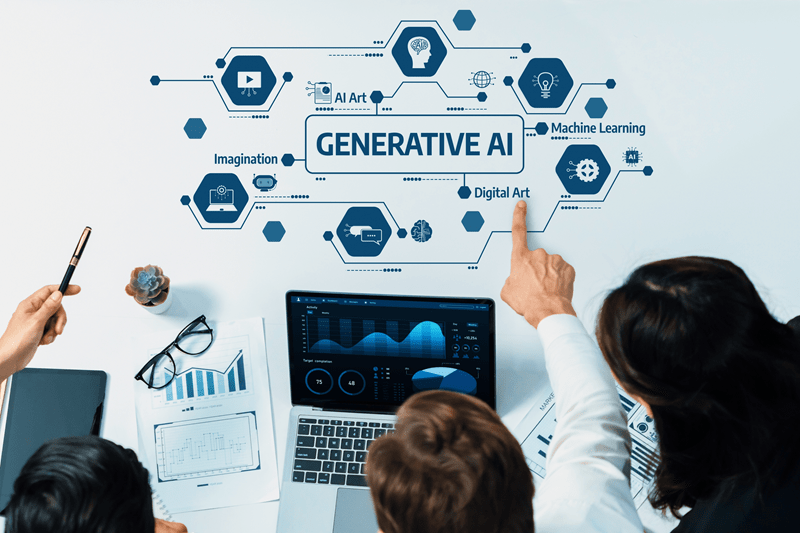
Companies want to move faster and make choices they can defend. A big part of this shift comes from generative ai becoming a normal part of everyday work. It is not treated as a fancy add-on anymore. It has become something teams rely on to sort through messy data, understand what matters and figure out what could happen next. When the data is clean and the systems are set up correctly, generative ai models turn scattered information into direction that feels clear and practical. And the more these systems get used, the more they learn. That constant loop is where the real value sits.
This breakdown goes into how generative ai, machine learning ai, predictive analytics and steady ai insights work together to support better data-driven decisions across different industries.
Generative ai creates new content after learning patterns from large datasets. It is not limited to labeling or sorting information. It produces something new based on what it has understood. This can be text, images, simulations, synthetic data or full scenario builds depending on the model.
Most generative ai models depend on deep learning. They study huge volumes of examples, catch patterns and learn how different variables connect. Once they understand those relationships, they can generate fresh output that follows similar logic. When they receive constant feedback, they get better quickly. Each cycle helps them improve. This is why steady use matters.
Machine learning ai adds another layer to this. Once generative systems work inside real business environments, they begin picking up how things shift over time. That is when the decision-making loop starts taking shape.
More to Discover: How AI Technology Is Changing Data Analysis for Businesses
Using generative ai regularly creates a loop where every cycle improves the next one. It works in a simple pattern.
Over time, ai insights become more aligned with how the business thinks and operates. Patterns become clearer. Teams waste less time guessing. The response speed improves. And when multiple departments use the system consistently, the loop becomes stronger and easier to scale.
The loop depends on the models behind it. Generative ai models come in different types. Some work with text, some with visuals, some with simulations and some with synthetic datasets. They all share one goal. They use data to build new output that helps teams look at problems from different angles.
For example:
When these generative systems work with machine learning ai, the results improve drastically. Machine learning handles prediction and classification. Generative models handle scenario building and creativity. Together, they create ai insights that feel more usable and grounded.
Predictive analytics has been a core tool for years. It looks at historical data and calculates what might happen next. It is still important, but modern decisions often require exploring several possibilities, not just the most likely one.
With all three working together, companies can compare options, plan for worst-case outcomes and prepare for unexpected situations. This makes decisions more complete, not rushed.
Must Read: Learn How Generative AI Is Transforming Software Development

Every action generates data. If the data gets used correctly, it becomes an advantage. Data-driven decisions supported by generative systems reduce uncertainty and help teams understand their choices better.
Here are a few reasons why this approach works.
Generative systems depend on consistent and organized data. Once companies fix fragmented inputs and build proper data foundations, generative ai models produce sharper and more reliable results.
People use tools they understand. When ai insights are simple, structured and easy to follow, adoption grows. The more people use it, the stronger the loop becomes.
When departments share information, machine learning ai and generative systems pick up connections humans might not notice. This supports better decisions across the entire company, not just one team.
Even with all these systems, humans stay in control. Generative ai can highlight patterns, test assumptions and surface options, but real context still comes from people. Many teams use a combined approach where both sides work together.
Human involvement matters for:
This balance ensures ai insights stay grounded and that decisions are practical and responsible.
Generative ai is already shaping different industries.
Teams use models to compare scenarios, test assumptions and understand the long-term impact of different choices.
Generative systems help create messaging, personalize content and anticipate customer behavior. Predictive analytics supports this by estimating how audiences may respond.
Financial teams use simulations and synthetic data to reduce risk and make faster decisions without relying solely on historical numbers.
Companies use a mix of machine learning ai and scenario building to predict delays, optimize routes, control inventory and reduce waste.
Generative systems help create synthetic patient data, generate research ideas and support drug discovery work.
All these uses aim at the same result. Better data-driven decisions with systems that grow smarter as they continue learning.
Generative ai models are powerful, but not perfect. Some challenges include:
These issues can be reduced by setting clear guidelines, validating outputs, maintaining strong data practices and keeping people in the loop. When this is done correctly, ai insights become much more dependable.
Explore More: Understand Ambient Intelligence: The Future of AI Innovation
Generative ai becomes more valuable every time it is used. The loop strengthens. The insights improve. The predictions get closer to real outcomes. When combined with predictive analytics, machine learning ai and strong data foundations, generative systems become a major driver of growth.
The companies that will benefit the most are the ones that use these tools consistently, measure their impact and keep humans involved. With that approach, generative systems do not just support decisions. They lift the entire decision-making process.
This content was created by AI